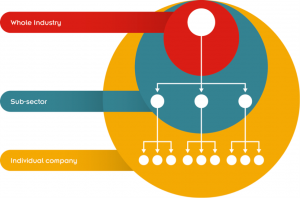Although the terms industry and sector are commonly swapped or are used interchangeably, they do, in fact, have to some extent different meanings. The difference in both of the words pertains to their scope. A sector refers to a large segment of the economy, while the term industry describes a much more specific group of companies or businesses.
A sector is one of a few general segments in the economy within which a large group of companies can be categorized. An economy is broken down into about a dozen sectors for analysis, which can describe nearly all of the business activity in that economy. For example, let’s look at Defense sector – you will find number of industries such as ammunition and missile, avionics (the electronic systems used on aircraft, artificial satellites, and spacecraft) specific transport vehicles, naval ships, shipbuilding, aerospace, metallurgy, small arms, ammunition, combat vehicles, artillery, tanks etc. The biggest sector is the world is oil and gas. 7 out of 10 largest-revenue companies are in this industry.
An industry, on the other hand, describes a much more specific grouping of companies with highly similar business activities. Fundamentally, industries are created by further breaking down sectors into more  defined groupings. Each of the dozen or so sectors will have a varying number of industries, but it can be in the hundreds. For example, Financial sectors is broken down by a broad range of businesses that manage money, including credit unions, banks, credit card companies, insurance companies, accountancy firms, consumer finance companies, mutual fund companies, asset management companies, asset recovery companies etc. When breaking down the economy, the first groups are sectors which describe a general economic activity. Then all of the companies that fall into that sector are categorized further into industries where they are grouped only with companies with which they share very similar business activities. This is not the end, however. Industries can be further sub-categorized into various, more specific groupings.
defined groupings. Each of the dozen or so sectors will have a varying number of industries, but it can be in the hundreds. For example, Financial sectors is broken down by a broad range of businesses that manage money, including credit unions, banks, credit card companies, insurance companies, accountancy firms, consumer finance companies, mutual fund companies, asset management companies, asset recovery companies etc. When breaking down the economy, the first groups are sectors which describe a general economic activity. Then all of the companies that fall into that sector are categorized further into industries where they are grouped only with companies with which they share very similar business activities. This is not the end, however. Industries can be further sub-categorized into various, more specific groupings.
It should be noted that you may find situations in which these two terms are reversed. However, the general idea remains: one breaks the economy down into a few general segments while the other further categorizes those into more specific business activities. In the stock market, the generally accepted terminology cites a sector as a broad classification and an industry as a more specific one.
However, these are words that denote different entities and must not be used interchangeably. The sector is a broader part of the economy while the industry is a sub-group of a sector. In other words, the sector is a large group that consists of industries having a particular type of companies doing the same business.
Sector Analysis gives a review and assessment of the current condition and future prospects of a given sector of the economy. Sector analysis serves to provide an investor with an idea of how well a given group of companies are expected to perform as a whole. More or less all economies are comprised of four, high-level sectors, which are then each made up of smaller sectors. Of the large sectors within an economy, the first is called the primary sector which involves companies that participate in the extraction and harvesting of natural products from the earth, such as agriculture, mining and forestry. The secondary sector consists of processing, manufacturing and construction companies. The tertiary sector is comprised of companies that provide services, such as retail sales, entertainment and financial organizations. The quaternary sector (knowledge based sector) is made up of companies in the intellectual pursuits, such as educational businesses.
Investors needs to study statistical relationships between industry trends and a range of economic and business variables and they need to develop practical, reliable industry forecasts by using various approaches to forecasting. One needs to check the chosen industries past trends, demand-supply mechanics and future point of view. Investors also need to examine industry performance in relation to other industries to identify industries with better/lesser returns and over time to conclude the degree of consistency, stability, and risk in the returns in the industry. Investor does analysis to identify industries that offer the highest potential for investment returns and lesser risks.













































